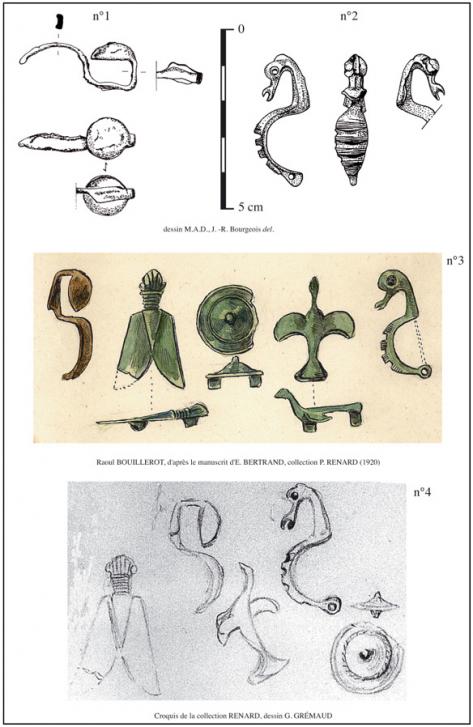Tumulus of the Bois de Taviard.
Publié 17/10/2018 16:28:11 Modifier 11/07/2019 09:59:43 par 489945901
It is located in a wood about 1400 m southeast of the tumulus of Rente-Neuve and 1500 m east of the tumulus of Bois de la Ronce.
#History #Tumulus #Hallstatt #Couchey Period: -550 to -300 years
Situation
It is located in a wood about 1400 m southeast of the Rente-Neuve tumulus and 1500 m east of the tumulus of Bois de la Ronce (Nicolardot, 2003, see inventories on page 325).
Structure and current state
We found this mound (Fig. 6) built using small and medium limestone blocks. It is "cratered" in the center almost to the natural ground, and the northwestern edge of the mound bears traces of other excavations, subsequent to the first central intervention.
Fig. 6.
Photograph of the tumulus of Bois de Taviard.
(Hollow Saint-Hubert) (snapshot B. Benoit).
Photograph of the tumulus of Bois de Taviard.
(Hollow Saint-Hubert) (snapshot B. Benoit).
History of excavations
Thanks to E. Bertrand, we know that it was explored in the early twentieth century. by P. Renard, with the probable participation of Cl. Drioton. In his manuscript, he mentions: "... This monument, 30 m in diameter and 4 m in height, was a real mass grave, but only one burial gave a beautiful bronze torque (Drioton Collection) ...". It is probably the torque wrongly attributed by G. Wamser to the tumulus of the Bois de la Ronce. The excavations of this mound had remained totally unpublished until then.
Place of deposit of the furniture: unknown.
furniture
The lack of precise information concerning excavations and furniture makes it difficult to date burials (Nicolardot, 2003, see inventories p.325).
However, two unprecedented protohistoric fibulae found on the commune of Couchey are shown on the plates of R. Bouillerot, without their precise location being indicated by E. Bertrand. They could come from these excavations. This hypothesis must however be considered with the greatest caution: it may be elements collected in another tumulus or in a habitat not specified by P. Renard. These two novel fibulae are of real chronological interest and they should be described in detail:
- A fragmented timbale iron fibula on the foot (Mansfeld type F4) (Fig. 7, No. 1). Long. : 30 mm.
This type of foot, which can be found both on copies of the final Hallstatt and La Tene old, does not allow in the absence of spring, to date more precisely this fibula. However, the section of the recessed arch seems to represent a characteristic type of an old Hallstatt D3 horizon. From a morphological point of view, a comparison exists with a fibula found on the habitat of Mont Lassois in Vix (Côte-d'Or) (Chaume, 2001, pl 8, n ° 94). Place of deposit: Archaeological Museum of Dijon.
- An incomplete ornithomorphic fibula (Fig. 7, No. 2). Long. : 37 mm.
The foot ends with an open-billed "duck's head" curving towards the arch of three notches formerly filled with coral. The intervals between the flutes are decorated with parallel fine streaks.
Found in 1997 at the Archaeological Museum of Dijon, this fibula resembles the copy reproduced on the plate of R. Bouillerot (Figure 7, No. 3), except at the treatment of the head. This last detail made the assertion of its provenance delicate. Fortunately, Dijon archaeologist G. Grémaud also drew (Fig. 7, No. 4) the same objects. His drawing of the fibula, with more precise features confirms that it is indeed the copy of Couchey.

Fig. 7.
Protohistoric fibula discovered in the commune of Couchey.
1-2. J.-R. Bourgeois del., Archaeological Museum of Dijon;
3. Raoul Bouillerot, after the manuscript of E. Bertrand, coll. P. Renard (1920);
4. sketch of the Renard collection, drawing G. Grémaud.
Protohistoric fibula discovered in the commune of Couchey.
1-2. J.-R. Bourgeois del., Archaeological Museum of Dijon;
3. Raoul Bouillerot, after the manuscript of E. Bertrand, coll. P. Renard (1920);
4. sketch of the Renard collection, drawing G. Grémaud.
Ornithomorphic "duck-headed" fibulae, probably produced in northern Italy, are widespread north and west of the Alps, as well as in eastern France (Kruta, 2000: 158). However, their dating is difficult to specify. They meet from Hallstatt D2 / D3 (second half of the 6th century BC to the late La Tene (second half of 5th century BC) (Feugère, Guillot, 1986). Most of these fibulae are attested in contexts dated from the early Hallstatt D3 / La Tene A (first half of the 5th century BC), as for example in Camp du Chateau "in Salins (Jura) where two specimens have been found in association with black-figure Attic cut fragments (Piningre, Ganard, 2004: 252).
In the regional context, the fibula of Couchey is related, by the treatment of the head and the decorations of striations on the arc, with the copy of Bragny-sur-Saône (Saône-et-Loire) dat% CC3 by the excavator of the second half of the 5th century. BC. J.-C. (Collet, Flouest, 1997, fig 3).
Two other models of the type "closed beak" have the same characteristics in terms of decorations on the bow: one comes from Bragny-sur-Saône (Feugère, Guillot, 1986, Fig. 33, No. 14) and the second Chassey camp (Thevenot, 1997, Fig. 4).
Electronic reference
Jean-Pierre Devaux, " The protohistoric environment of Mount Africa: unpublished data on tumulus excavations carried out in the late nineteenth century. and in the early 20th century. in Couchey (Côte-d'Or) », Archeological Review of the East, Volume 56 | 2007, posted on February 20, 2009, accessed on November 16, 2015.
Author
Jean-Pierre Devaux, amateur archaeologist, 21 rue de la Combette, hamlet of Domois, 21600 Fenay, © All rights reserved.
Link to the original electronic documents:
https://rae.revues.org/5236
Location +/- 4 meters.